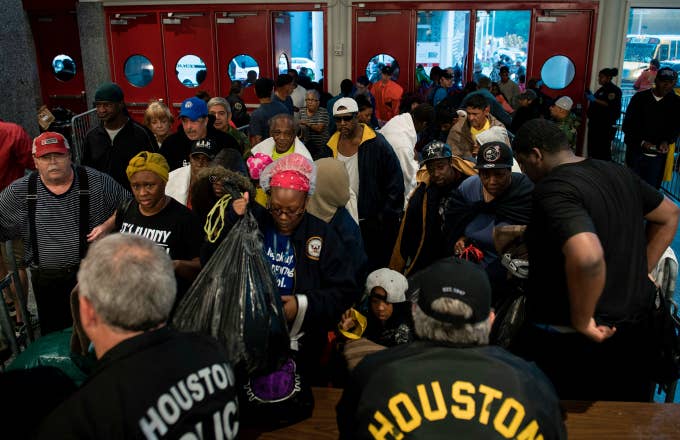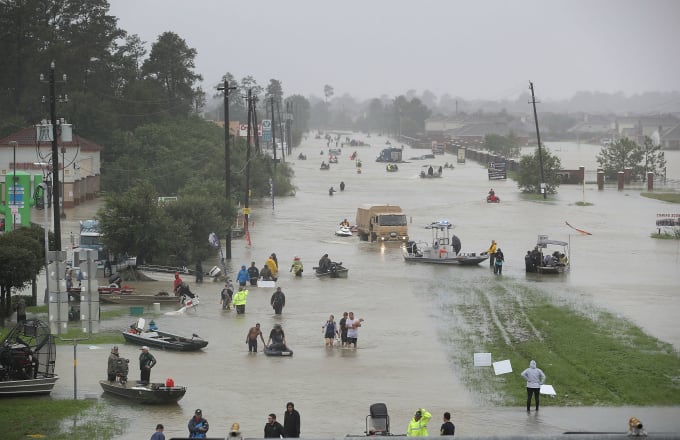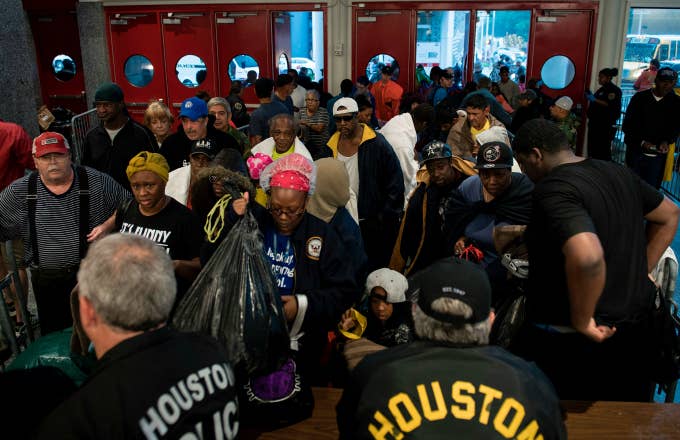
“We had to figure it out. No one was coming to save us,” said black Houston resident Tiffany Jackson.
Jackson, her husband and their three kids—who are 14, 12, and eight months old—were waiting for rescue from Tropical Storm Harvey (previously Hurricane Harvey) for over 17 hours. They kept calling rescue services, but the operators said the sheriffs wouldn’t let them through to their area, the Verde Forest subdivision in Northeast Houston.
Once the water got up to their chests, they knew they had to rescue themselves. Jackson tied her baby to her chest, and they waded out into the deluge. Eventually, through the support of neighbors, the family made it to the dry house of a friend who lives in another part of their neighborhood. In the course of their journey, they lost the bag that held their wallet and cash.
Jackson’s neighborhood, where law enforcement would not let rescue efforts enter, is about 62 percent black, 32.6 percent Latinx and 4.4 percent white. We don’t yet know which parts of Houston have received the worst flooding, but we do know that certain populations will be harder hit and find it more difficult to recover long-term. Like Jackson’s neighborhood, the parts of Houston receiving the least aid already seem to be home to the city's most vulnerable populations—including people of color, those in poverty, immigrants, and the elderly.
“The Red Cross is great, but they’re an hour away,” said Jackson. “They might start passing out water bottles over here in like three days. We’re still underwater, the roads aren’t clear, and you know they’re going to clean up our end of town after that end of town.”
People of color—who are disproportionately poor—are less likely to have the resources and mobility to evacuate. So are those with disabilities, homeless folks, and elderly individuals. Undocumented immigrants are particularly endangered, because Customs and Border Patrol refused to shut down immigration checkpoints during the storm, creating a situation in which undocumented Houstonians had to choose between risking deportation or staying home amidst the flooding. Direct Relief, an emergency aid organization, has created a series of maps showing where vulnerable populations are concentrated in Harvey’s path.
Harvey demonstrates how natural disasters and climate change disproportionately impact people of color.
Structural racism was already present in Houston—and reinforced by government institutions—long before the storm began exacerbating it. In Houston, around 26 percent of black and 27 percent of Latinx residents live below the poverty line, compared to just eight percent of white residents. Eighty percent of households earning $200,000 or more are white. Harvey also demonstrates how natural disasters and climate change disproportionately impact people of color, who are more likely to live in regions and neighborhoods at risk for such catastrophes.
Wealth dictates who will be able to regroup following the storm—just 17 percent of homeowners in the areas most impacted by Harvey have flood insurance, meaning the vast majority of families will have to rely on the government or donations to rebuild.
Absent larger-scale relief, community members are banding together to lift each other up. Jackson has been receiving PayPal donations through an effort organized by fellow Houston resident Roni Dean-Burren, in which folks can contribute directly to the cash apps of black women struggling through Harvey. “My initial thought was who would be most impacted by the storm, and that’s always marginalized people living in poverty,” Dean-Burren said of how she came up with the idea for #SupportBlackWomenHOU.
“Because of the intersection at which we live as black women, things are less accessible for us, and we can often be ignored,” Dean-Burren continued. As of Thursday, the campaign had already raised at least $20,000 for over 250 black women who had signed up.
On Wednesday, when the campaign went live, Jackson received about $65 in donations. “Right now, today, these donations are saving our lives,” she said. “The direct donation is what we need. I don’t have five days. I applied for FEMA but it’s pending. Well, my children’s appetite is not pending... The girls needed pads yesterday. That’s not pending.”
Ashton Woods, founder and organizer of Black Lives Matter Houston (BLMHOU), has been coordinating relief efforts for Houston residents—making runs to buy basic supplies such as food and toiletries, which he is taking to local rescue shelters using donated funds and his pickup truck. Right before our conversation, an individual who had seen his Facebook Live video surprised Woods at Costco by covering his entire $1,200 bill for relief supplies.
“I’m a Katrina survivor, and I would say that Houston is at or surpassing that situation,” Woods related. “I’m extremely triggered by all of this, but I’m working through it... I don’t have a choice, people need help.”

As Woods highlighted, this devastating state of affairs draws parallels to Hurricane Katrina, where the most catastrophic conditions touched the same marginalized populations. New Orleans is a mostly black city, and many speculated that the lack of swift, effective governmental response to Katrina was rooted in racism. Most of the hurricane’s deadly toll was taken upon black folks; in some parts of New Orleans the death rate was four times as high for black individuals as their white counterparts. After Katrina, FEMA provided trailers to 63 percent of residents from mostly white St. Bernard Parish, but to just 13 percent of the mostly black Lower Ninth Ward.
The racial discrimination and trauma still impacting Katrina survivors can be examined to avoid the same mistakes in Houston, survivors believe.
“After a disaster like this the first thing you want to do is provide some kind of shelter, and help people rebuild and have a home again. The data show that homelessness is a significant predictor of developing post traumatic stress disorder,” explained Denese Shervington, President of Institute of Women and Ethnic Studies in New Orleans. A psychiatrist with a public health focus, Shervington has been working to rebuild her city over the past 12 years and address the psychological trauma experienced by communities of color.
Shervington found that the basic physical necessities needed to support people of color following Katrina were too often missing, and the corresponding mental health impacts ignored and untreated. She does not want to see the same happen in Houston. “This is when government has to be very proactive, and recognize that vulnerable people who are poor, who have been marginalized, need a lot of support and that’s OK. They can’t pull themselves up by their bootstraps because they don’t have any bootstraps to pull up.”
Once Houston dries out we will see the full extent of the damage and loss of human lives. We will see what areas were hit the hardest. But it’s clear that marginalized communities with fewer resources to begin with need extra support and compassion to piece their lives back together.
Those who wish to make direct donations to black women displaced by Harvey can go here.

